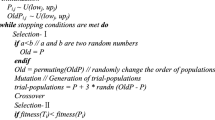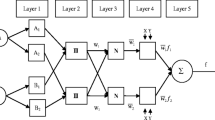Abstract
The fuzzy time series (FTS) model has been proposed for many years, and many researches have been conducted to improve or enhance the model. This study proposed a novel method for stock forecasting, which is based on FTS forecasting with genetic algorithm (GA)-fuzzy C-means (FCM) and multifactor back-propagation neural networks (BPNN). The GA algorithm is utilized to alleviate the FCM’s issue of falling into local optimum in the process of partitioning the universe of discourse and fuzzifying the time series. The multifactor BPNN considers relatively more information to train the neural networks and then forecast new stock index fluctuations. Finally, the proposed method is compared with other previous research methods by using SSECI and TAIEX data to verify the proposed method’s effectiveness and efficiency in forecasting financial time series.









Similar content being viewed by others
References
Aladag CH, Basaran MA, Egrioglu E et al (2009) Forecasting in high order fuzzy times series by using neural networks to define fuzzy relations. Expert Syst Appl 36(3):4228–4231
Altiparmak F, Gen M, Lin L et al (2006) A genetic algorithm approach for multi-objective optimization of supply chain networks. Comput Ind Eng 51(1):196–215
Armano G, Marchesi M, Murru A (2005) A hybrid genetic-neural architecture for stock indexes forecasting. Inf Sci 170(1):3–33
Askari S, Montazerin N (2015) A high-order multi-variable fuzzy time series forecasting algorithm based on fuzzy clustering. Expert Syst Appl 42(4):2121–2135
Askari S, Montazerin N, Zarandi MHF (2015) A clustering based forecasting algorithm for multivariable fuzzy time series using linear combinations of independent variables. Appl Soft Comput 35:151–160
Athanasopoulos G, Ashton S (2012) Multivariate exponential smoothing for forecasting tourist arrivals. J Travel Res 51(5):640–652
Atsalakis GS, Valavanis KP (2009) Forecasting stock market short-term trends using a neuro-fuzzy based methodology. Expert Syst Appl 36(7):10696–10707
Bezdek JC (1981) Pattern recognition with fuzzy objective function algorithms. Kluwer Academic Publishers, Dordrecht
Cai QS, Zhang D, Wu B et al (2013) A novel stock forecasting model based on fuzzy time series and genetic algorithm. Proc Comput Sci 18:1155–1162
Cai Q, Zhang D, Zheng W et al (2015) A new fuzzy time series forecasting model combined with ant colony optimization and auto-regression. Knowl Based Syst 74:61–68
Che JX (2014) A novel hybrid model for bi-objective short-term electric load forecasting. Int J Electr Power Energy Syst 61:259–266
Chen SM (1996) Forecasting enrollments based on fuzzy time series. Fuzzy Sets Syst 81(3):311–319
Chen MY, Chen BT (2014) Online fuzzy time series analysis based on entropy discretization and a Fast Fourier Transform. Appl Soft Comput 14:156–166
Chen MY, Chen BT (2015) A hybrid fuzzy time series model based on granular computing for stock price forecasting. Inf Sci 294:227–241
Chen SM, Tanuwijaya K (2011) Fuzzy forecasting based on high-order fuzzy logical relationships and automatic clustering techniques. Expert Syst Appl 38(12):15425–15437
Cheng CH, Cheng GW, Wang JW (2008) Multi-attribute fuzzy time series method based on fuzzy clustering. Expert Syst Appl 34(2):1235–1242
Egrioglu E, Aladag CH, Yolcu U et al (2011) Fuzzy time series forecasting method based on Gustafson–Kessel fuzzy clustering. Expert Syst Appl 38(8):10355–10357
Fogel DB (1994) An introduction to simulated evolutionary optimization. IEEE Trans Neural Netw 5(1):3–14
Guo Z, Wu J, Lu H et al (2011) A case study on a hybrid wind speed forecasting method using BP neural network. Knowl Based Syst 24(7):1048–1056
Holland JH (1975) Adaptation in natural and artificial systems: an introductory analysis with applications to biology, control, and artificial intelligence. University of Michigan Press, Ann Arbor
Hong WC (2011) Traffic flow forecasting by seasonal SVR with chaotic simulated annealing algorithm. Neurocomputing 74(12):2096–2107
Hong WC, Dong Y, Chen LY et al (2011) SVR with hybrid chaotic genetic algorithms for tourism demand forecasting. Appl Soft Comput 11(2):1881–1890
Huang YL, Horng SJ, Kao TW et al (2011) An improved forecasting model based on the weighted fuzzy relationship matrix combined with a PSO adaptation for enrollments. Int J Innov Comput Inf Control 7(7A):4027–4046
Huarng K, Yu THK (2006) The application of neural networks to forecast fuzzy time series. Physica A 363(2):481–491
Lee WJ, Hong J (2015) A hybrid dynamic and fuzzy time series model for mid-term power load forecasting. Int J Electr Power Energy Syst 64:1057–1062
Mai T, Ghosh B, Wilson S (2014) Short-term traffic-flow forecasting with auto-regressive moving average models. Proc Inst Civ Eng Transp 167(4):232–239
Pappas SS, Ekonomou L, Karamousantas DC et al (2008) Electricity demand loads modeling using AutoRegressive Moving Average (ARMA) models. Energy 33(9):1353–1360
Park JH, Park YM, Lee KY (1991) Composite modeling for adaptive short-term load forecasting. IEEE Trans Power Syst 6(2):450–457
Rumelhart DE, Hinton GE, Williams RJ (1988) Learning representations by back-propagating errors. Cognit Model 5(3):1
Saab S, Badr E, Nasr G (2001) Univariate modeling and forecasting of energy consumption: the case of electricity in Lebanon. Energy 26(1):1–14
Song Q, Chissom BS (1993a) Fuzzy time series and its models. Fuzzy Sets Syst 54(3):269–277
Song Q, Chissom BS (1993b) Forecasting enrollments with fuzzy time series—part I. Fuzzy Sets Syst 54(1):1–9
Xiao Z, Ye SJ, Zhong B et al (2009) BP neural network with rough set for short term load forecasting. Expert Syst Appl 36(1):273–279
Ye F, Zhang L, Zhang D et al (2016) A novel forecasting method based on multi-order fuzzy time series and technical analysis. Inf Sci 367:41–57
Yolcu OC, Yolcu U, Egrioglu E et al (2016) High order fuzzy time series forecasting method based on an intersection operation. Appl Math Model 40(19):8750–8765
Yu L, Wang S, Wen F et al (2012) Genetic algorithm-based multi-criteria project portfolio selection. Ann Oper Res 197(1):71–86
Zadeh LA (1965) Fuzzy sets. Inf Control 8(3):338–353
Zhang WY, Zhang SX, Zhang S et al (2017) A multi-factor and high-order stock forecast model based on type-2 FTS using cuckoo search and self-adaptive harmony search. Neurocomputing 240:13–24
Funding
This study was funded by China National Nature Science Foundation (Nos. 51375429, 51475410) and Zhejiang Natural Science Foundation of China (No. LY13E050010).
Author information
Authors and Affiliations
Corresponding author
Ethics declarations
Conflict of interest
The authors declare that they have no conflict of interest.
Ethical approval
This article does not contain any studies with human participants or animals performed by any of the authors.
Additional information
Communicated by V. Loia.
Rights and permissions
About this article
Cite this article
Zhang, W., Zhang, S., Zhang, S. et al. A novel method based on FTS with both GA-FCM and multifactor BPNN for stock forecasting. Soft Comput 23, 6979–6994 (2019). https://doi.org/10.1007/s00500-018-3335-2
Published:
Issue Date:
DOI: https://doi.org/10.1007/s00500-018-3335-2




